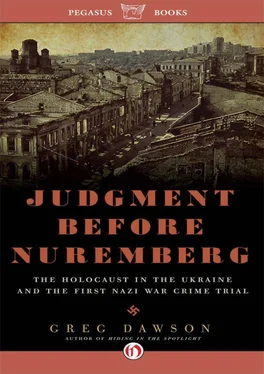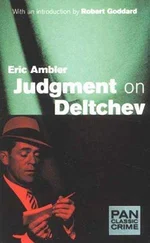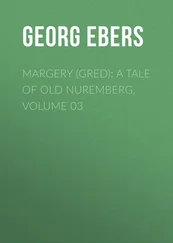The living, those who made it to the factory, would soon envy the dead. The buildings at the complex had no heat or running water; a galaxy of broken windows produced conditions of a giant meat locker. The captives were given no food (some had brought scraps from home) and the only “water” was a filthy liquid more likely to cause diarrhea than to slake thirst. The women’s “toilet” was a shed with three holes in the ground. It was a sight my mother could never forget, or forgive.
It was inhuman. The sight of women the age of my mother and grandmother made me shake in shame for the Germans. I wanted to put those who created this hell in the same place as these women. That’s where I wanted Hitler and Himmler and Goebbels.
After two weeks in this fresh circle of hell, after hundreds had frozen or starved or died of disease, after the German soldiers had taken a day off from killing to celebrate Christmas and then the New Year, the surviving Jews were ordered to relinquish all their valuables and prepare once again for transport. Their destination was not a labor camp in Poltava as they had repeatedly been told. Poltava was to the south, and they were being marched in a different direction. The scales at last had fallen from Dmitri Arshansky’s eyes. He did not know where it would end, but he knew instinctively it was a final journey. Perhaps he also sensed that they were now less than two miles from a place with no exit.
As the throng of doomed Jews—organized in rows of six, the size of the Arshansky family—crept toward their fate, Dmitri reached deep into a pocket of his winter coat and pulled out a gold watch he had managed to conceal when the Nazis were confiscating property. He flashed it at a young Schutzmannschaften walking alongside. “Look at me,” Dmitri said quietly, “you can see that I am not a Jew. Please just turn your eyes away and let my little girl go.” The guard snatched the watch. “Let her go and I will pretend not to see.”
Zhanna, walking next to Dmitri, heard the exchange. Moments later, she saw her opportunity up ahead—two babushkas by the side of the road watching the march. Next to them on the ground was a mass of unraveled barbed wire. She would leap from the line and pretend to become entangled in the wires, just another observer. Her father slipped his coat over fourteen-year-old Zhanna’s slender shoulders, and she was gone.
I became one of the gray women, just watching the column. I saw a German looking straight at me, and I thought he would stop and grab me, but he kept going.
So did her family. Zhanna watched them disappear over the horizon. Frina is the only one she would ever see again. They found each other days later in Kharkov, but Frina has refused to reveal how she escaped. Maybe she dashed out of line as Zhanna did, or she reached Drobitsky Yar with her parents and grandparents and miraculously dodged their horrible fate at the bottom of the ravine. I suspect we will never know.
I had come to Kharkov to make that final journey, to walk the same route from the tractor factory to Drobitsky Yar. And this time, unlike my first visit in 2006, I would not stop at the precipice. This time I would go to the depths of the yawning ravine that swallowed the 16,000 human sacrifices to Hitler’s Judenfrei fantasies. In 2006, I’d been there on a cloudless September day when the ravine and graves and monuments to horror were bathed in a sunny, narcotizing glow. This time I would be walking in the same punishing cold as December 15, 1941.
I was no martyr to my mission, however. I did not intend to freeze. The forecast called for a high of 15 degrees, and I planned to walk in the morning before the mercury shot up to double digits. This was tough for a guy from Florida who does not retain heat well to begin with. For the first time in my life, I put on a pair of long johns, black and form-fitting. Looking in the mirror, I felt like the lead in an AARP production of Spider-Man. To that layer I added a shirt and a padded vest. For my feet, three pairs of heavy-duty socks and instant-heat insoles from the hunting-gear aisle at Outdoor World. My neighbor had loaned me a pair of hiking boots suitable for Grizzly Adams. I had gloves the label said were made for “extreme cold,” but I had tested them in downtown Kharkov and my fingertips were freezing in 15 minutes. Watching Ukrainians passing by, I figured out their secret to warm hands: keep them in your pockets. I had a scarf to cover my face and a stocking cap to keep the heat from escaping through my head. Finally, a puffy new coat made of a poly-synthetic, wind-resistant material—a gift from my mother on my last visit to see her before the trip. I already had a good winter coat, but she was insistent.
“You will need this,” she said. “I do not want you to be cold.”
Those words were so familiar. They seemed almost ritualistic, an incantation. My mother was in the habit of presenting winter coats to me and my brother Bill and other family as gifts. They were given with love, but also with a measure of passion and urgency not usually attached to an article of clothing. Not until that morning in my hotel room in Ukraine, as I dressed for the walk to Drobitsky Yar, did I stop to wonder: Every time my mother insistently handed me a new coat, was she unconsciously reliving the moment her father had placed his coat on her shoulders before she escaped the death march?
I fortified myself for the journey with a breakfast of eggs, cheese, baked cabbage and peppers, black bread with honey and apple preserves, and strong coffee in the lovely Hotel Chichikov dining room where, per widespread local custom, smoking is still allowed—and enjoyed. The young English-speaking desk staff had called a cab for me, explaining my destination to the driver who spoke even less English than I do Russian. Of the thirty or so random words I retained from my bilingual childhood, most are not survival words for a tourist, unless you need information about a dog, pencil, room, housefly, movie, or herring.
I settled my Michelin Man shape into the back seat of the cab and exchanged smiles across the language barrier with the twenty-something driver.
“Dobray ootra (good morning),” I said, clearly surprising him.
“Dobray ootra!”
“Drobitsky Yar?” I said hopefully.
“Da, da.”
In fact, I was not going all the way to Drobitsky Yar. I was getting out at the site of the tractor factory, the temporary ghetto, and then walking the final distance to the ravine. I had been to the ghetto site in 2006 and had passed it just the day before when I traveled by bus with a large group to a commemorative service at Drobitsky Yar. We would end up hopelessly lost in translation if I tried to explain all this to the driver. I would just have to point as we approached the ghetto site.
From the Chichikov we wended through side streets to downtown and then to Moscow Prospect. In 1941 it was a rutted rural road suitable for donkey carts. Today it’s a major four-lane thoroughfare lined with a hodgepodge of commercial development and the occasional factory and apartment complex. It’s no place for pedestrians, but development thins after a few miles and the countryside creeps closer to the pavement. I could see the ghetto site coming up on the right. The wooded acreage is enclosed by a forest-green, corrugatedmetal security fence that stood out against the wintry tableau.
I motioned for the driver to pull over, and he gave me a quizzical look. “Drobitsky Yar,” he insisted, pointing straight ahead.
I motioned again for him to pull over, more dramatically this time, and he decided not to mess with the crazy American. Once we were stopped, I tried to explain that I was going to walk the rest of the way.
“Drobitsky Yar,” I said, pointing to myself and doing the international sign language for walking with two fingers.
Читать дальше












